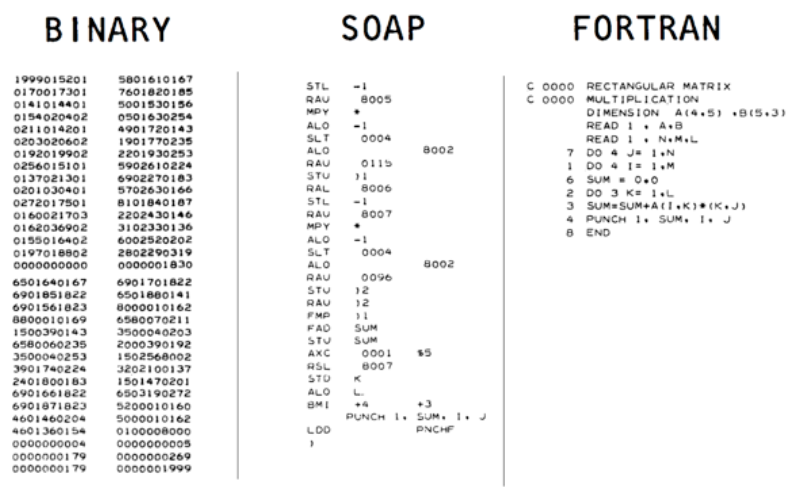What is a Compiler?
A function that maps an input string to an output string.
compiler :: String -> StringTypically, the input and output strings are “programs”
compiler :: SourceProgram -> TargetProgram
What is a Compiler?
For example, here are some well-known compilers
gcc, clang :: C -> Binary -- a.out, .exe
ghc :: Haskell -> Binary
javac :: Java -> JvmByteCode -- .class
scalac :: Scala -> JvmByteCode
ocamlc :: Ocaml -> OcamlByteCode -- .cmo
ocamlopt :: Ocaml -> Binary
gwt :: Java -> JavaScript -- .js
v8 :: JavaScript -> Binary
nasm :: X86 -> Binary
pdftex :: LaTeX -> PDF
pandoc :: Markdown -> PDF | Html | DocKey Requirements on output program:
- Has the same meaning (“semantics”) as input,
- Is executable in relevant context (VM, microprocessor, web browser).
A Bit of History
Compilers were invented to avoid writing machine code by hand

Richard Hamming – The Art of Doing Science and Engineering, p25:
In the beginning we programmed in absolute binary… Finally, a Symbolic Assembly Program was devised – after more years than you are apt to believe during which most programmers continued their heroic absolute binary programming. At the time [the assembler] first appeared I would guess about 1% of the older programmers were interested in it – using [assembly] was “sissy stuff”, and a real programmer would not stoop to wasting machine capacity to do the assembly.
John A.N. Lee, Dept of Computer Science, Virginia Polytechnical Institute
One of von Neumann’s students at Princeton recalled that graduate students were being used to hand assemble programs into binary for their early machine. This student took time out to build an assembler, but when von Neumann found out about it he was very angry, saying that it was a waste of a valuable scientific computing instrument to use it to do clerical work.
What does a Compiler look like?

An input source program is converted to an executable binary in many stages:
- Parsed into a data structure called an Abstract Syntax Tree
- Checked to make sure code is well-formed (and well-typed)
- Simplified into some convenient Intermediate Representation
- Optimized into (equivalent) but faster program
- Generated into assembly
x86 - Linked against a run-time (usually written in C)
What is CSE 131 ?
A bridge between two worlds
- High-level: ML (CSE 130)
- Machine Code: X86/ARM (CSE 30)
A sequel to both those classes.
How to write a compiler for
NanoML -> X86- Parsing
- Checking & Validation
- Simplification & Normalizing
- Optimization
- Code Generation
But also, how to write complex programs
- Design
- Implement
- Test
- Iterate
How write a Compiler?
General recipe, applies to any large system
- gradually, one feature at a time!
We will
- Step 1 Start with a teeny tiny language,
- Step 2 Build a full compiler for it,
- Step 3 Add a few features,
- Go to Step 2.
(Yes, loops forever, but we will hit Ctrl-C in 10 weeks…)
Logistics: Who are we?
Prof:
- Ranjit Jhala
TAs:
- Nico Lehmann
Tutors:
- Kyeling Ong
- Benson Vuoung
Logistics: 131 will be In-Person
Lectures
- live and in-person
- lectures will be podcasted
- lectures will not streamed)
Exams
- will be in-person at announced time slot
Clicker
- class participation
Logistics: How will we grade?
(5%) Class Participation
- Answering questions with the clicker, register in this google form
(30%) Assignments
- 6-7 programming assignments done in groups of up to 2
(30%) Midterm
- In person Thursday May 5th, from 9:30 – 10:50am
(35%) Final
- In person Tuesday June 8th, from 8:00 – 11:00am
Exams are closed book
- You may use a double-sided cheat sheet.
Course Outline
We will write a compiler for NanoML -> X86
But Rome wasn’t built in a day … and neither is any serious software.

So we will write many compilers:
- Numbers and increment/decrement
- Local Variables
- Nested Binary Operations
- Booleans, Branches and Dynamic Types
- Functions
- Tuples and Structures
- Lambdas and closures
- Types and Inference
- Garbage Collection
What will you learn ?
Core principles of compiler construction
- Managing Stacks & Heap
- Type Checking
- Intermediate forms
- Optimization
Several new languages
Haskellto write the compilerCto write the “run-time”X86compilation target
More importantly how to write a large program
- How to use types for design
- How to add new features / refactor
- How to test & validate
What do you need to know ?
This 131 depends very heavily on CSE 130
- Familiarity with Functional Programming and Haskell
- Datatypes (e.g. Lists, Trees, ADTs)
- Polymorphism
- Recursion
- HOFs (e.g.
map,filter,fold)
Also depends on CSE 30
- Experience with some
Cprogramming - Experience with some assembly (
x86)
A few words on the medium of instruction
We will use Haskell
- If you took 130 with Ocaml then haskell is similar
Haskell has many advanced features beyond what we saw in 130, but we won’t be using them; in the few cases we do, I’ll explain them as we go.
Here are some links to get you started:
Lets Begin!
